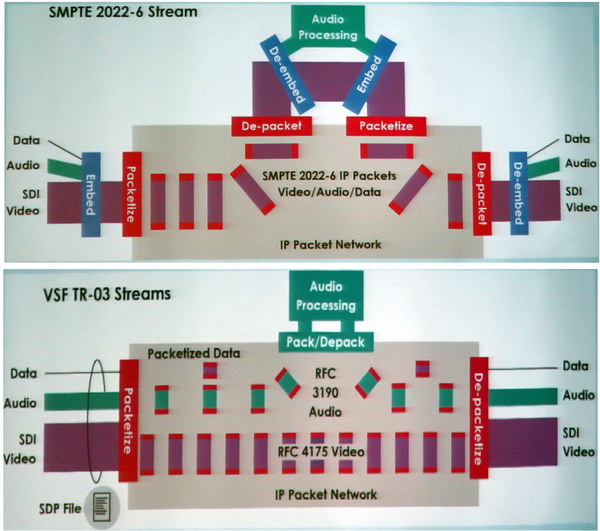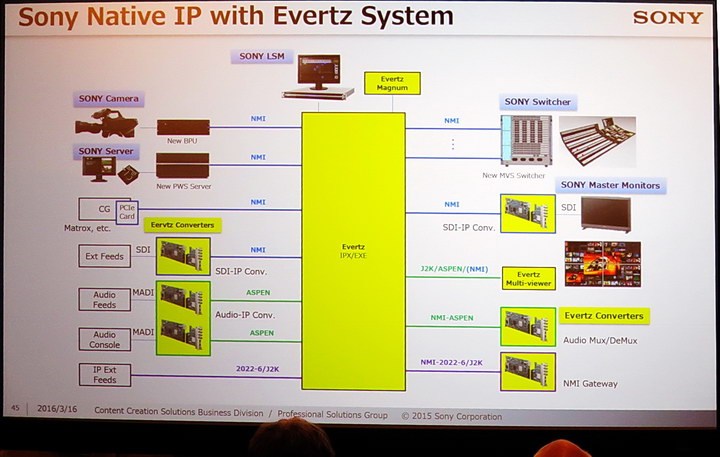Real-time, broadcast-quality, uncompressed video over IP has been a hot topic in the content-creation and broadcast industries recently where it is seen as a replacement for dedicated video SDI interfaces. In fact, last month I wrote a feature article for Large Display Monitor and Mobile Display Monitor (subscription required) covering a half-day seminar hosted by Snell Advanced Media (SAM) on the topic. SAM had piggy-backed this seminar on top of a two day training session for its customers on the topic that focused, in part, on the use of SAM hardware in an IP environment.

The SMPTE New York Section had a well-attended meeting on the topic titled “Video over IP in a Production Environment” on March 16th. The meeting was held at the AT&T Video Management Center in lower Manhattan, headquarters for AT&T Global Broadcast Video Services. After a brief introduction by AT&T, there were four speakers at the meeting:
- Wes Simpson, Telecom Product Consulting
- John Mailhot, Imagine Communications
- Deon LeCointe, Sony Professional Solutions of North America
- Paul Briscoe, Evertz Corporation (Briscoe gave his presentation via video conference)
Wes Simpson, Deon LeCointe and John Mailhot (L to R) answering questions after the formal presentations
For video over IP to work in a multi-vendor environment, standards are required, especially since the IP environment was not originally designed for real-time video. This is where SMPTE and several other standards setting bodies come in. The first two speakers focused primarily on the standards themselves. Unfortunately for the post-production and broadcast communities, there are multiple standards related to video over IP and not all of these standards are finished yet. In fact, one key standard from SMPTE hasn’t even been assigned a reference number yet and is still called “ST-21XX.”
Some of the other standards are not yet formally approved but the drafts are far enough along that there are unlikely to be major changes between now and the formal approval. Most of the likely changes are expected to be software- or parameter-related. If there are important changes, hardware owners can expect a software or firmware update from the equipment vendors.
 Relationship between various standards needed by video over IP given by John Mailhot
Relationship between various standards needed by video over IP given by John Mailhot
These standards come from a variety of standards organizations, including:
- SMPTE (Society of Motion Picture and Television Engineers)
- EBU (European Broadcasting Union)
- VSF (Video Services Forum)
- AES (Audio Engineering Society)
- IEEE (Institute of Electrical and Electronics Engineers)
SMPTE and the EBU are probably well known to Display Daily readers. The VSF is a trade group for companies interested in video and says about itself “the VSF is an international association comprised of service providers, users and manufacturers dedicated to interoperability, quality metrics and education for video networking technologies.” Imagine Communications, Sony, Evertz and SAM are all members of the VSF.
The AES, while less familiar to DD readers, has established standards for digital audio and the transmission of digital audio over IP networks. Since these are the standards used by the video industry to transmit the audio associated with the video, these standards must be part of any video over IP standard.
The IEEE is a major player in the IP part of video over IP. One IEEE standard, in particular, is needed by video over IP, the Precision Time Protocol (PTP, IEEE 1588-2008). PTP was jointly established by the IEEE in cooperation with NIST, the US National Institute of Standards and Technology. The PTP is a protocol used to synchronize clocks throughout a computer network. On a local area network, it achieves clock accuracy in the sub-microsecond range, making it suitable for video, measurement and control systems. This PTP synchronization performs the Genlock function for video over IP transmissions.
Unfortunately, the SMPTE standard (ST-2020-6) and the VSF standard (VSF TR-03/04) differ from each other in at least one significant way. The SMPTE standard calls for sending the audio in the same packets over the IP network as the associated video. The logic behind this is it makes it impossible for the video and audio to be separated from each other – if you have the video, you automatically have the audio associated with it with the correct lip-sync.
The VSF standard sends the audio, video and the ancillary data in separate packets over the packetized IP network. Since every packet of video, audio and data sent has the associated frame ID number, there is said to be no problem re-associating the audio with the video at the receiver and get correct lip-sync. Since the video data for a single video frame takes more than one packet to transmit it, this packet re-association at the destination is needed anyway and imposes no extra overhead burden. The VFS approach makes it easier to process the audio independently of the video, something that is often needed. No need to de-packetize the video and de-embed the audio from the video for audio processing such as level adjustment. All you need to do is de-packetize the audio packets, process the audio, re-packetize the audio into new packets with the frame ID code and send the audio on its way.
 Comparison between SMPTE 2022-6 with embedded audio and data and VSF TR-03 where audio and data travel in their own packets
Comparison between SMPTE 2022-6 with embedded audio and data and VSF TR-03 where audio and data travel in their own packets
SMPTE is working on a standard to allow these two methods to work together. This is the standard that has not yet been assigned a number and is known as ST-21XX.
Sony and Evertz have their own flavors of video over IP. Sony calls theirs NMI (Networked Media Interface) and Evertz calls theirs Aspen. Sony has a NMI users group Called the IP Live Alliance with 45 partners and Evertz has a users group called the Aspen Community with 31 members.
Confused by the conflicting standards and the sheer number of new standards needed to shift form SDI to video over IP? Don’t worry, everyone is. Once you strip away the confusion, it appears the industry is converging on solutions that can be used in content creation and broadcast production applications. For example, Imagine Communications, Evertz and SAM are members of Sony’s NMI IP Live Alliance and Sony is a member of Evertz’s Aspen Community.
In addition, SMPTE and the VSF have hosted a number of Inter-Op events where competitors such as Sony, Evertz, SAM and the many other manufacturers of video over IP hardware and software can be in the same room and have their hardware or software talk to the competitor hardware or software to confirm multi-vendor interoperability. Paul Briscoe of Evertz is not expecting a VHS vs Beta or Blu Ray vs HD-DVD battle over SMPTE vs VSF standards. In addition, Sony’s Deon LeCointe showed a slide of a system that Sony had put together for a Latin American customer that included components from both Sony and Evertz to show the systems are compatible in practice as well as in theory.
 Sony and Evertz Hardware can work together and both work with legacy SDI equipment. Click on image for higher resolution
Sony and Evertz Hardware can work together and both work with legacy SDI equipment. Click on image for higher resolution
The NAB 2016 show is coming to Las Vegas April 16 – 21. This is the key US trade show for the creation, management and delivery of content across all platforms. For NAB 2016, 103,000 attendees from 166 countries and 1,700+ exhibitors are expected. Sony, Evertz and SAM will all be there, as well as almost every other hardware and software supplier you have ever heard of. SMPTE and the IEEE will also have official presences on the show floor. Any NAB attendee should be prepared to see a lot of video over IP demonstrations. The industry is moving quickly from SDI to video over IP distribution because of the lower expected cost and greater flexibility of video over IP compared to SDI. As John Mailhot of Imagine described it, NAB 2015 showed what could be done in terms of video over IP but NAB 2016 will show what has been done.
– Matthew Brennesholtz

